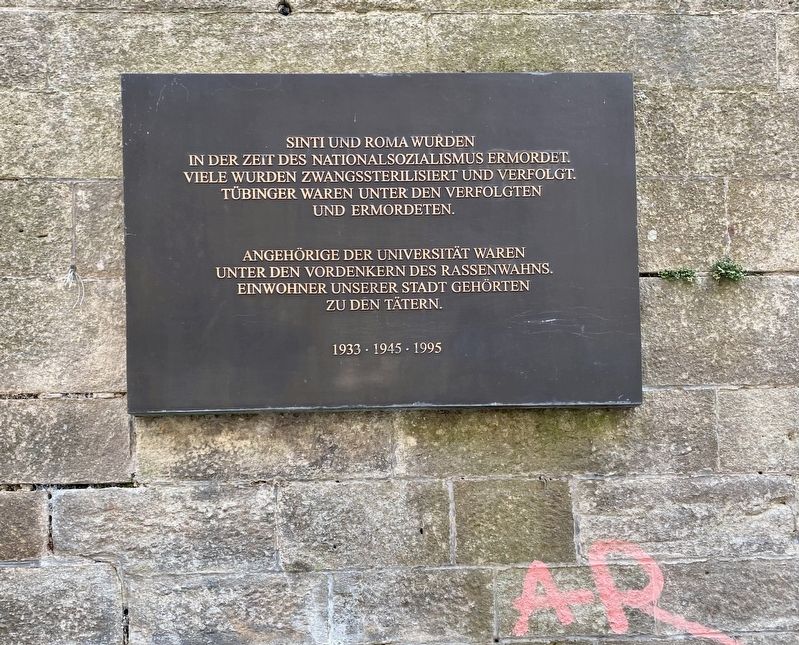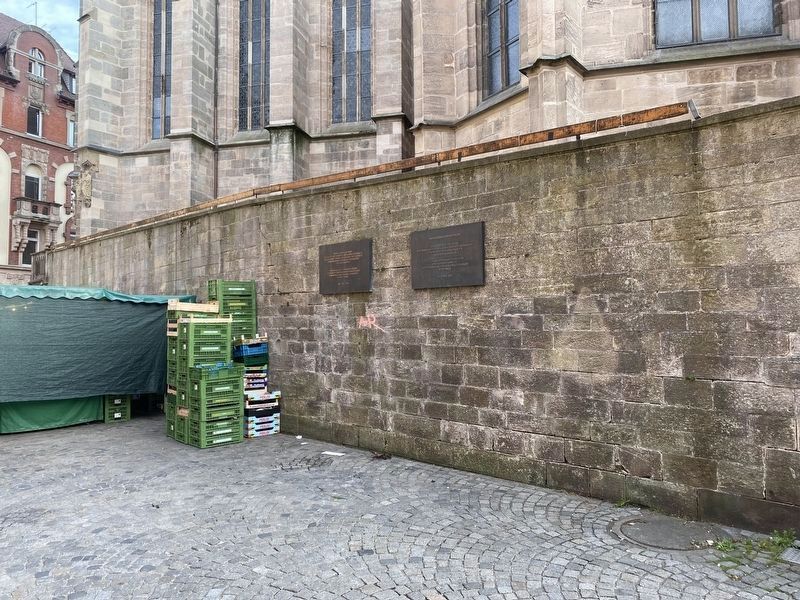Tübingen, Baden-Württemberg, Germany — Central Europe
Tübingen Roma and Sinti Memorial
Angehörige der Universität waren unter den Vordenkern des Rassenwahns. Einwohner unserer Stadt gehörten zu den Tätern.
1933 · 1945 · 1995
Sinti and Roma were murdered during the Nazi era. Many were forcibly sterilized and persecuted. Tübingen citizens were among the persecuted and murdered.
Members of the university were amongst the masterminds of racial fanaticism. Residents of our city were amongst the perpetrators.
1933 · 1945 · 1995
Erected 1995 by Universität Tübingen.
Topics and series. This memorial is listed in this topic list: War, World II. In addition, it is included in the The Holocaust series list.
Location. 48° 31.216′ N, 9° 3.382′ E. Marker is in Tübingen, Baden-Württemberg. Memorial is at the intersection of Holzmarkt and Neckargasse, on the right when traveling east on Holzmarkt. Touch for map. Marker is at or near this postal address: Holzmarkt 1, Tübingen BW 72070, Germany. Touch for directions.
Other nearby markers. At least 8 other markers are within walking distance of this marker. University of Tübingen Holocaust Memorial (here, next to this marker); An Example of "Aryanization": The Oppenheim and Schäfer Families Clothing Store (here, next to this marker); Buchhandlung Gastl / Gastl Bookstore (within shouting distance of this marker); Nikodemus Frischlin (within shouting distance of this marker); Josef Eberle (Sebastian Blau) (within shouting distance of this marker); Hermann Hesse (within shouting distance of this marker); Bebenhäuser Pfleghof (within shouting distance of this marker); Theodor Dannecker: Täter des Holocaust / Perpetrator of the Holocaust (within shouting distance of this marker). Touch for a list and map of all markers in Tübingen.
Also see . . .
1. The genesis and course of the Nazi persecution of Roma and Sinti (E.H.M.D.S.R.). A brief essay on the Nazi persecution of Roma and Sinti, presented by the European Holocaust Memorial Day for Sinti and Roma, as excerpted from "The Destruction of European Roma in KL Auschwitz: A guidebook for visitors".
Excerpt: "The situation of Roma and Sinti after Hitler’s seizure of power in Germany was a result of several overlapping processes: (1) the intensification of the way the already existing discriminatory regulations were implemented, which led to increased control of Roma and Sinti by the authorities; (2) the limitation of both the opportunities to live a traditional Roma life and those for integration with the life of majority; (3) the large scale employment of scientific procedures of registration and classification; (4) the introduction of new legal regulations directed against Roma and Sinti, based on racist ideology and leading to their exclusion from society. The situation of Roma and Sinti in other European countries was similar, particularly in those in which the modernization process was advanced....The general number of Roma victims is difficult to estimate because of the lack of precise documentation by the perpetrators, and lack of reliable statistics about Roma living in Europe before the Second World War. On the basis of the existing written sources we may speak of ca. 200,000 Roma victims. But the real number must be much higher, probably amounting to 500,000."(Submitted on October 9, 2022.)
2. Persecution Of Roma (Gypsies) In Prewar Germany, 1933–1939 (United State Holocaust Memorial Museum). Entry from the Holocaust Encyclopedia.
Excerpt: "Dr. Robert Ritter, a physician at the University of Tuebingen, became the central figure in the study of Roma. His specialty was criminal biology; that is, the idea that criminal behavior is genetically determined. In 1936, Ritter became the director of the Center for Research on Racial Hygiene and Demographic Biology in the Ministry of Health and began a racial study of Roma. Ritter undertook to locate and classify by racial type Roma living in Germany, often collaborating with the police. He estimated that the Roma and Sinti population in Germany at the time was around 30,000. He performed medical and anthropometric examinations in an attempt to classify Roma. His team of researchers interviewed Roma to determine and record their genealogy, often under the threat of arrest and incarceration in concentration camps unless they identified their relatives and their last known residence.... At the conclusion of his study, Ritter declared that although Roma had originated in India and were therefore once Aryan, they had been corrupted by mingling with lesser peoples during their long migration to Europe. Ritter estimated that some 90 percent of all Roma in Germany were of mixed blood and were consequently carriers of "degenerate" blood and criminal characteristics. Because they allegedly constituted a danger, Ritter recommended they be forcibly sterilized. The remaining pure-blooded Roma, Ritter argued, should be studied further. In practice, little distinction was made between Ritter's so-called pure-blooded and mixed-blooded Roma. They all became subject to the Nazi policy of persecution and, later, mass murder."(Submitted on October 9, 2022.)
Credits. This page was last revised on October 9, 2022. It was originally submitted on October 9, 2022, by Andrew Ruppenstein of Lamorinda, California. This page has been viewed 76 times since then and 9 times this year. Photos: 1, 2. submitted on October 9, 2022, by Andrew Ruppenstein of Lamorinda, California.

